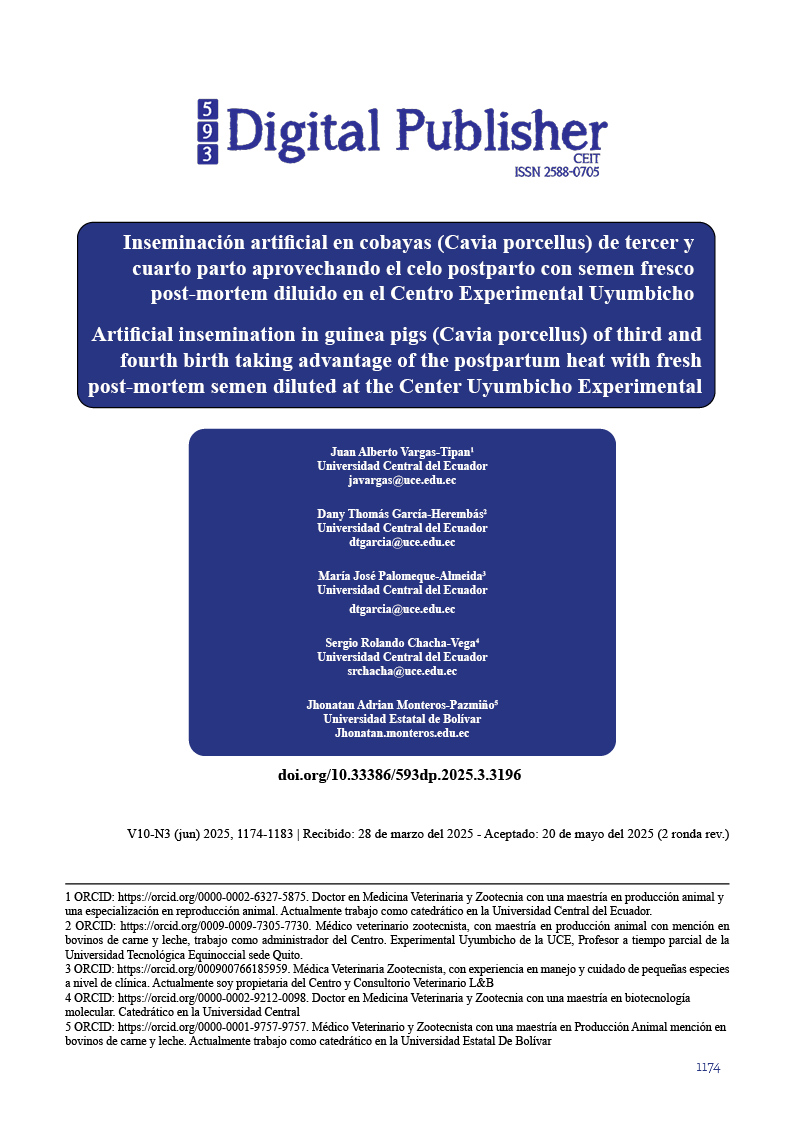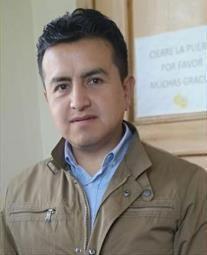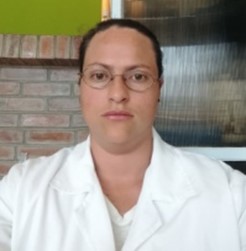Artificial insemination in guinea pigs (Cavia porcellus) of third and fourth birth taking advantage of the postpartum heat with fresh post-mortem semen diluted at the Center Uyumbicho Experimental
Main Article Content
Abstract
Artificial insemination (AI) is a reproductive biotechnology used to improve genetics and prevent the transmission of diseases in various animal species. However, its application in guinea pigs (Cavia porcellus) is limited due to the lack of standardized protocols and challenges in semen collection and preservation. General Objective: To evaluate the feasibility of AI in third- and fourth-parity guinea pigs using fresh diluted post-mortem semen, taking advantage of postpartum estrus at the Uyumbicho Experimental Center. Methodology: A total of 60 guinea pigs (40 females and 20 males) were divided into two experimental groups based on AI timing: early (2-6 hours postpartum) and late (8-12 hours postpartum). Semen was obtained through post-mortem epididymal extraction, and its macroscopic and microscopic characteristics were evaluated using the AndroVision® system. AI was then performed, and pregnancy diagnosis was conducted via ultrasound at 45 days. Results: The pregnancy rate was 90% for early AI and 65% for late AI. Sperm concentration and motility varied, influencing fertilization efficiency. Conclusion: AI in guinea pigs is viable if performed within the optimal insemination window, with early postpartum estrus being the most effective. However, developing specific protocols is necessary to improve sperm quality and standardize the procedure in this species.
Downloads
Article Details

This work is licensed under a Creative Commons Attribution-NonCommercial-ShareAlike 4.0 International License.
1. Derechos de autor
Las obras que se publican en 593 Digital Publisher CEIT están sujetas a los siguientes términos:
1.1. 593 Digital Publisher CEIT, conserva los derechos patrimoniales (copyright) de las obras publicadas, favorece y permite la reutilización de las mismas bajo la licencia Licencia Creative Commons 4.0 de Reconocimiento-NoComercial-CompartirIgual 4.0, por lo cual se pueden copiar, usar, difundir, transmitir y exponer públicamente, siempre que:
1.1.a. Se cite la autoría y fuente original de su publicación (revista, editorial, URL).
1.1.b. No se usen para fines comerciales u onerosos.
1.1.c. Se mencione la existencia y especificaciones de esta licencia de uso.
References
Almeida, A. J. (2016). Influencia de las espículas peneanas del cobayo sobre el comportamiento sexual, valoración espermática y fertilidad del macho. https://dspace.ucuenca.edu.ec/items/1bcedde6-6b17-4cf4-b91c-4ab12f1633f8
Barahona, M., & Quishpe, O. (2012). Inducción de superovulación en cobayas primerizas, usando gonadotropina sérica con tres dosis diferentes. Universidad Central del Ecuador.
Carpio, S. V. (2015). Evaluación de dos diluyentes para la crioconservación de semen bovino: Yema de huevo vs leche descremada [B.S. thesis]. https://dspace.ups.edu.ec/handle/123456789/7955
Franco, J., & Uribe, L. F. (2012). Hormonas reproductivas de importancia veterinaria en hembras domésticas rumiantes. Biosalud, 11(1), 41-56.
Loor, A. I. (2015). Caracterización morfológica del espermatozoide del cobayo (Cavia porcellus) en el cantón Latacunga. https://repositorio.utc.edu.ec/items/097de01b-447e-4f81-b415-9973d911b748
Pinduisaca, F. (2018). Colecta y evaluación de semen de cuyes (Cavia porcellus) extraído por la técnica de electroeyaculación en el centro Experimental Uyumbicho [PhD Thesis]. Tesis de grado. Universidad Central del Ecuador. Quito-Ecuador.
Quispe, W. (2018). Características espermáticas y calidad del semen de dos razas de cuyes (Cavia porcellus), en el Valle de Cajamarca. https://repositorio.unc.edu.pe/handle/20.500.14074/2132
Riva, S. de la. (2018). Inmunomodulación del eje hipotálamo-hipófisis-gónada: Valoración del conejo como biomodelo para el estudio de la fisiología de la reproducción. https://docta.ucm.es/entities/publication/5932d0d7-a807-4eeb-9379-9320db387ff3
Rosero, M. A. R., Núñez, O. P., & Lozada, E. E. (2018). Evaluación de tres diluyentes naturales para semen fresco de conejo en la inseminación artificial. Journal of the Selva Andina Animal Science, 5(1), 23-32.
Ruiz, M. E., Rivera, B., & Ruiz, A. (1998). Reproducción animal: Métodos de estudio en sistemas. Iica. https://books.google.es/books?hl=es&lr=&id=KCWbKne5eLcC&oi=fnd&pg=PA9&dq=Ruiz,+M.,+Rivera,+B.,+%26+Ruiz,+A.+(1998).+Reproducci%C3%B3n+Animal:+M%C3%A9todos+de+estudio+en+sistemas.+San+Jos%C3%A9:+RISPAL.&ots=n0fv65T56r&sig=FPXzpvQxsE6dtVHsD67FZJ0fI1U
Serres, C. (2012). Métodos tradicionales y alternativos de extracción de semen. Revista Complutense de Ciencias Veterinarias, 6(2), 125.
Tapia, D. A., & Tello, D. J. (2016). Evaluación cuali-cuantitativa de espermatozoides de la cola del epedídimo de cuyes cavia porcellus criollos y mejorados en dos edades reproductivas. https://dspace.ucuenca.edu.ec/items/790d7b73-2018-47a8-b4d9-83939c1a8f17
Vaca, J. L. (2017). Evaluación de tres diluyentes naturales para semen fresco de conejo (oryctolagus cuniculus) en la inseminación artificial. https://repositorio.uta.edu.ec/items/fc6a1df2-af05-4a38-9390-088c0c202b55
Villamarín, K. K. (2016). Evaluación de dos crioprotectores (Etilenglicol y propilenglicol) en la conservación lenta de ovocitos en cobayos (cavia porcellus) en el laboratorio de la carrera de medicina veterinaria. https://repositorio.utc.edu.ec/items/2e06ff5b-f431-4ccd-be51-c1d3f574f34d






